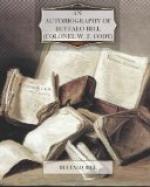The wagon-train, which had been ordered to come up, had not arrived. Fearful that it had been surrounded, General Carr ordered the command to return and look for it. We found it at nine o’clock that night, and went into camp.
Next morning, when we moved down the creek, not an Indian was to be seen. Village and all, they had disappeared. Two miles down the stream we came to a spot where the village had been located. Here we found many articles which had been left in the hurry of flight. These we gathered up and burned.
The trail, which we followed as rapidly as possible, led northeast toward the Republican River. On reaching that stream a halt was ordered. Next morning at daylight we again pulled out. We gained rapidly on the Indians, and could occasionally see them from a distance.
About eleven o ’clock that morning, while Major Babcock was ahead with his company, and as we were crossing a deep ravine, we were surprised by perhaps three hundred warriors. They at once began a lively fire. Our men galloped out of the ravine to the rough prairie and returned it. We soon succeeded in driving the enemy before us. At one time we were so close upon them that they threw away most of their lodges and camp equipment, and left their played-out horses behind them. For miles we could see Indian furniture strewn in all directions.
Soon they scattered into small bodies, dividing the trail. At night our horses began to give out, and a halt was called. A company was detailed to collect all the loose Indian ponies, and to burn the abandoned camp equipment.
We were now nearly out of rations. I was sent for supplies to the nearest supply point, old Fort Kearney, sixty miles distant.
Shortly after this the command reached Fort McPherson, which for some time thereafter continued to be the headquarters of the Fifth Cavalry. We remained there for ten days, fitting out for a new expedition. We were reenforced by three companies of the celebrated Pawnee Indian Scouts, commanded by Major Frank North. At General Carr’s recommendation I was now made chief of scouts in the Department of the Platte, with better pay. I had not sought this position.
I became a firm friend of Major North and his officers from the start. The scouts had made a good reputation for themselves. They had performed brave and valuable services in fighting against the Sioux, whose bitter enemies they were. During our stay at Fort McPherson I made the acquaintance of Lieutenant George P. Belden, known as “The White Chief.” His life has been written by Colonel Brisbin, of the army. Belden was a dashing rider and an excellent shot. An hour after our introduction he challenged me to a rifle match, which was at once arranged.
We were to shoot ten shots each at two hundred yards for fifty dollars a side. Belden was to use a Henry rifle. I was to shoot my old “Lucretia.” This match I won. Belden at once proposed another, a hundred-yard match, as I was shooting over his distance. This he won. We were now even, and we stopped right there.




